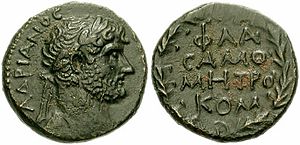Samosata
Arshamasht (armenian Առշամաշատ) | |
 | |
| Location | Turkey |
|---|---|
| Region | Adıyaman Province |
Samosata (/səˈmɑːsətə/; Armenian: Շամուշատ, Template:Lang-grc Samósata, Template:Lang-syr šmīšaṭ) was an ancient city on the right (west) bank of the Euphrates, whose ruins exist at the previous location of the modern city of Samsat, Adıyaman Province, Turkey but are no longer accessible as the site was flooded by the newly constructed Atatürk Dam. Even though the city had a predominantly Syriac-speaking population, Hellenistic culture played an important role there.[1] The city is sometimes confused with Arsamosata.
History

| |
| O: laureate head of Hadrian | R: within wreath: |
| bronze coin struck by Hadrian in Samosata 117-138; ref.: BMC 22 | |
The founder of the city was Sames, a king of Armenia.[2]
Located in southeast Turkey on the upper Euphrates River, it was fortified so as to protect a major crossing point of the river on the east-west trade route. It also served as a station on another route running from Damascus, Palmyra, and Sura up to Armenia and the Euxine Sea. For a time, the city was called Antiochia in Commagene (Template:Lang-grc). As Antiochia in Commagene, it served as the capital for the Hellenistic kingdom of Commagene from c. 160 BC until it was surrendered to Rome in 72. A civil metropolis from the days of Emperor Hadrian, Samosata was the home of the Legio VI Ferrata and later Legio XVI Flavia Firma, and the terminus of several military roads.

It was at Samosata that Julian II had ships made in his expedition against Sapor, and it was a natural crossing-place in the struggle between Heraclius and Chosroes in the 7th century.
In February 1098, the emir Baldoukh (Bulduk) of the Turkish Artukid or Ortoqid (Artuklu) dynasty, attacked by Baudouin of Antioch, cut his army to pieces there. In 1114 it was one of the chief quarters of the Muslims hostile to the Count of Edessa, to whom it succumbed, but was recaptured by the Muslims about 1149.
Samosata was the birthplace of several renowned people from antiquities such as Lucian (c. 120-192) and Paul of Samosata (fl. 260).
In Christianity
In the Christian martyrology, seven Christian martyrs were crucified in 297 in Samosata for refusing to perform a pagan rite in celebration of the victory of Maximian over the Sassanids: Abibus, Hipparchus, James, Lollian, Paragnus, Philotheus, and Romanus. Saint Daniel the Stylite was born in a village near Samosata; Saint Rabbulas, venerated on 19 February, who lived in the 6th century at Constantinople, was also a native of Samosata. A Notitia Episcopatuum of Antioch in the 6th century mentions Samosata as an autocephalous metropolis (Echos d'Orient, X, 144); at the synod that reinstated Patriarch Photius I of Constantinople (the Photian Council) of 879, the See of Samosata had already been united to that of Amida (Diyarbakır).[3] As in 586 the titular of Amida bears only this title ([4]), it must be concluded that the union took place between the 7th and the 9th centuries. Earlier bishops included Peperius, who attended the Council of Nicaea (325); Saint Eusebius of Samosata, a great opponent of the Arians, killed by an Arian woman (c. 380), honoured on 22 June; Andrew, a vigorous opponent of Cyril of Alexandria and of the Council of Ephesus.[5]
Chabot gives a list of twenty-eight Syrian Miaphysite bishops.[6] The Syrian bishopric probably lapsed in the 12th century.[7] Samosata is included in the Catholic Church's list of titular sees, but no further titular bishops have been appointed for that eastern see since the Second Vatican Council.
Modern Samsat
Ancient Samosata continues to the present day as the Turkish town of Samsat. The old town of Samsat was submerged in 1989 under the Ataturk Dam. A new town bearing the same name was built for the population dislocated by the sinking of the old town. Modern Samsat is a town of approximately 2000 inhabitants. It is the capital of the district of the same name in the Turkish province of Adıyaman.
Notes
- ^ A Journey to Palmyra (p. 114)
- ^ Toumanoff, Cyril Studies in Christian Caucasian History (1963), p. 280 and 292, Georgetown University Press
- ^ Mansi, Conciliorum collectio, XVII-XVIII, 445.
- ^ Le Quien, Oriens christianus, II, 994.
- ^ Le Quien, Oriens christianus, II, 933-6.
- ^ Revue de l'Orient chrétien, VI, 203.
- ^ Fiey, J. M. (1993), Pour un Oriens Christianus novus; répertoire des diocèses Syriaques orientaux et occidentaux, Beirut, p. 263, ISBN 3-515-05718-8
External links
- Orontid dynasty
- Commagene
- Roman sites in Turkey
- History of Armenia
- Buildings and structures in Adıyaman Province
- Former populated places in Turkey
- Thughur
- Archaeological sites in Southeastern Anatolia
- Catholic titular sees in Asia
- History of Adıyaman Province
- Visitor attractions in Adıyaman Province
- Geography of Adıyaman Province

